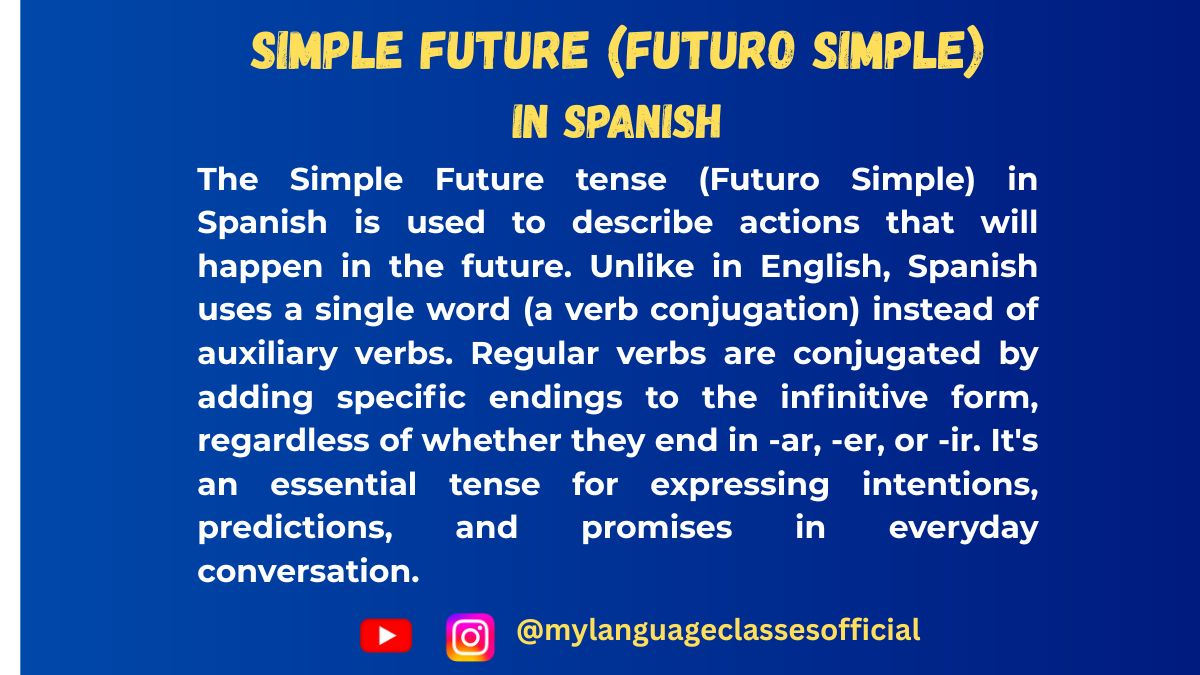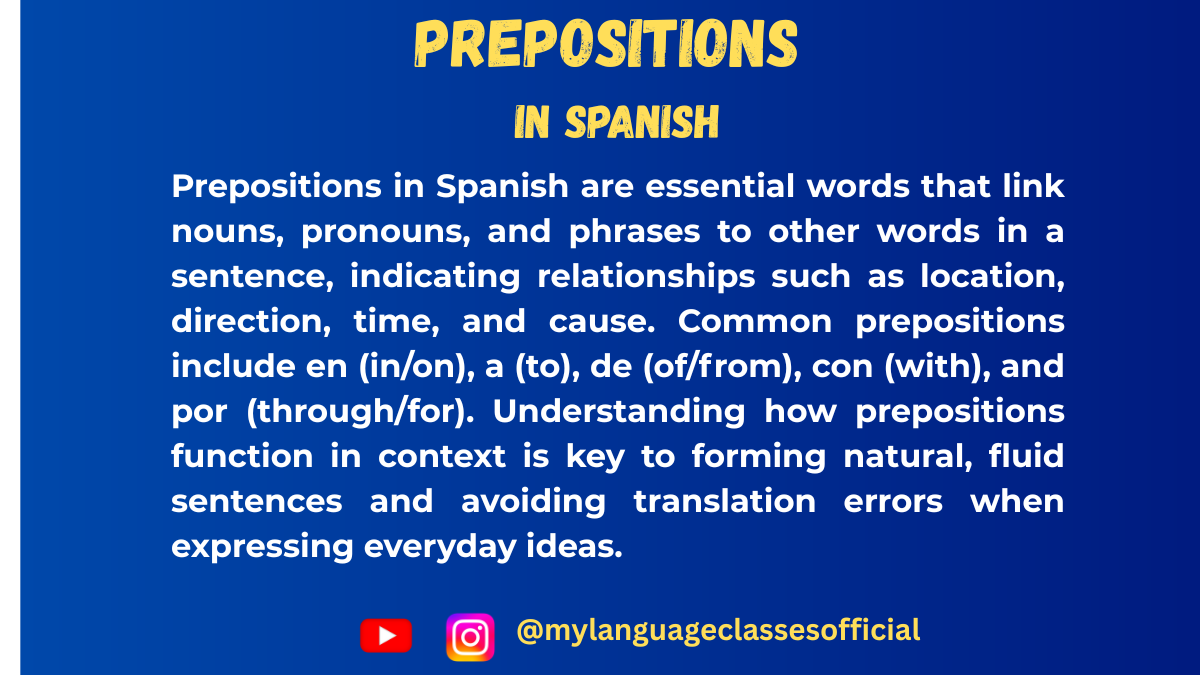Your cart is currently empty!
Tag: DELE
-

Pretérito Pluscuamperfecto (Past Perfect) in Spanish
The Pretérito Pluscuamperfecto, also known as the Past Perfect, is a verb tense used in Spanish to describe actions that occurred before another action in the past. It is commonly used in storytelling, recounting experiences, and expressing regrets or unrealized conditions.
How to Form the Pretérito Pluscuamperfecto
The Pretérito Pluscuamperfecto is formed using the imperfect tense of the auxiliary verb ‘haber’ + the past participle of the main verb.
Conjugation of ‘haber’ in Imperfect Tense
Subject Conjugation Yo Había Tú Habías Él/Ella/Usted Había Nosotros/Nosotras Habíamos Vosotros/Vosotras Habíais Ellos/Ellas/Ustedes Habían Forming the Past Participle
The past participle is formed by:
- -ar verbs → replacing -ar with -ado (e.g., hablar → hablado)
- -er and -ir verbs → replacing -er/-ir with -ido (e.g., comer → comido, vivir → vivido)
Uses of Pretérito Pluscuamperfecto
- To describe actions that happened before another past event
- Cuando llegué, ellos ya se habían ido. (When I arrived, they had already left.)
- To express past experiences before another event
- Nunca había visto una película tan emocionante. (I had never seen such an exciting movie.)
- To express regrets or missed opportunities
- Ojalá me hubieras avisado antes. (I wish you had told me earlier.)
- To talk about indirect speech in the past
- Dijo que ya había comido. (He said that he had already eaten.)
- To describe conditions in hypothetical past situations
- Si hubieras estudiado, habrías aprobado. (If you had studied, you would have passed.)
Common Expressions with Pretérito Pluscuamperfecto
Spanish Expression Meaning in English Ya había terminado I had already finished Nunca había visto I had never seen Todavía no había llegado I hadn’t arrived yet Antes de que llegara Before (he/she) arrived Apenas había empezado I had just started No había entendido nada I hadn’t understood anything Cuando llegué, ya se había ido When I arrived, (he/she) had already left No me había dado cuenta I hadn’t realized
Regular Verbs in Pretérito Pluscuamperfecto
Verb Yo Tú Él/Ella/Usted Nosotros Vosotros Ellos/Ellas/Ustedes Example Sentences Hablar (to talk) Había hablado Habías hablado Había hablado Habíamos hablado Habíais hablado Habían hablado 1. Cuando llegué, ellos ya habían hablado.
2. Nunca había hablado con ella antes.Comer (to eat) Había comido Habías comido Había comido Habíamos comido Habíais comido Habían comido 1. Ya había comido antes de salir.
2. Nunca había comido sushi.Vivir (to live) Había vivido Habías vivido Había vivido Habíamos vivido Habíais vivido Habían vivido 1. Había vivido en España por cinco años.
2. Nunca había vivido solo antes.
Irregular Verbs in Pretérito Pluscuamperfecto
Verb Past Participle Example Sentence Hacer (to do/make) Hecho Había hecho la tarea antes de la clase. Decir (to say) Dicho Nunca había dicho eso antes. Ver (to see) Visto Había visto esa película muchas veces. Escribir (to write) Escrito Habíamos escrito una carta. Romper (to break) Roto Había roto mi teléfono accidentalmente.
More Example Sentences
- Cuando llegué a casa, mi madre ya había cocinado.
- Nunca había viajado en avión antes.
- Habíamos hablado de este tema antes.
- Ya habías leído el libro cuando te lo recomendé.
- Ellos nunca habían visitado París.
- Cuando llegó la profesora, los estudiantes ya habían terminado el examen.
- Mi hermano había estudiado mucho antes del examen.
- Nosotros nunca habíamos visto un espectáculo tan impresionante.
- Habías olvidado mi cumpleaños otra vez.
- Antes de que saliera el sol, ya habíamos caminado muchos kilómetros.
Things to Keep in Mind
- Agreement in gender and number does not apply because the past participle remains the same.
- Articles like ‘el’ and ‘la’ follow standard noun rules.
- In negative sentences, ‘no’ comes before ‘haber’ (e.g., No había entendido).
- Reflexive verbs place the pronoun before ‘haber’ (e.g., Me había despertado temprano).
Fill in the Blanks
- Cuando llegué, ya ______ (terminar) la reunión.
- Nosotros nunca ______ (ver) una película tan interesante.
- Antes de salir, ya ______ (hacer) la tarea.
- Mi hermana ya ______ (decidir) qué estudiar.
- No me ______ (dar cuenta) de la hora.
- Cuando lo llamé, él ya ______ (salir) de casa.
- Nosotros ______ (comer) antes de la película.
- Cuando empezó la clase, ellos ya ______ (leer) el libro.
- Ella nunca ______ (visitar) ese museo antes.
- No ______ (escuchar) sobre ese problema antes.
Answers
- Había terminado 2. Habíamos visto 3. Había hecho 4. Había decidido 5. Había dado cuenta 6. Había salido 7. Habíamos comido 8. Habían leído 9. Había visitado 10. Había escuchado
Conclusion
The Pretérito Pluscuamperfecto is essential for narrating past events that happened before another past action. Mastering this tense helps in better storytelling, expressing regrets, and making past comparisons. Keep practicing with different verbs and contexts to use it naturally in conversations!
If you enjoyed this lesson, be sure to check out more posts like this on my blog at My Language Classes. Don’t forget to subscribe my YouTube channel and follow me on Instagram for the latest language learning tips and lessons. Leave a comment below to share your thoughts, or ask any questions you have about nouns.
Happy learning! 😊
- 100 Spanish Example Sentences
- 100 Spanish Fill-in-the-Blanks Exercises
- 100 Spanish Vocabulary Lists
- Spanish – Advanced
- Spanish – Beginner
- Spanish – Intermediate
-
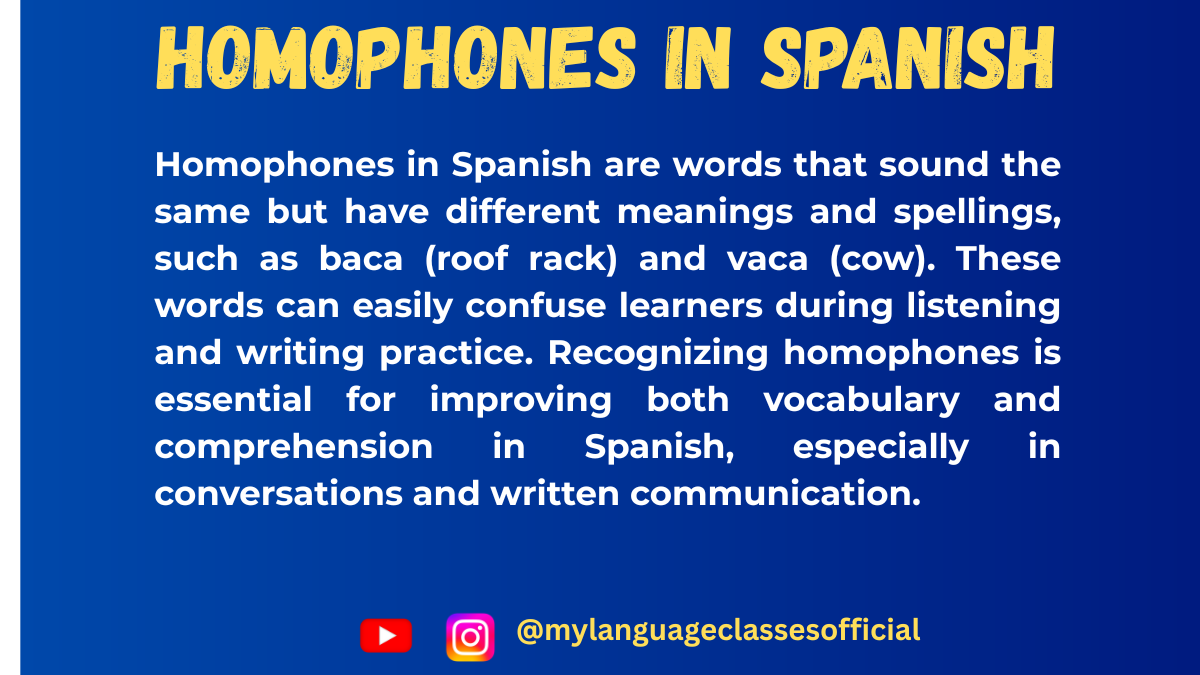
Differentiating Homophones in Spanish: Tú vs. Tu, Él vs. El, and Others
What Are Homophones?
Homophones are words that sound the same but have different meanings and spellings. In Spanish, many homophones exist due to the presence or absence of accent marks (tildes), which change the meaning of a word entirely. Understanding these differences is crucial for mastering Spanish grammar and avoiding misunderstandings in writing and speech.
Common Homophones in Spanish
Below is a list of frequently confused homophones in Spanish, along with their meanings and example sentences.
Homophones Meaning 1 Meaning 2 Example Sentence 1 Example Sentence 2 Tú / Tu (Pronoun) You (Possessive adjective) Your Tú eres muy simpático. (You are very nice.) Tu casa es grande. (Your house is big.) Él / El (Pronoun) He (Article) The Él es mi hermano. (He is my brother.) El coche es rojo. (The car is red.) Más / Mas (Adverb) More (Conjunction) But Quiero más comida. (I want more food.) Quise ir, mas no pude. (I wanted to go, but I couldn’t.) Sí / Si (Adverb) Yes (Conjunction) If Sí, quiero ir. (Yes, I want to go.) Si tienes tiempo, llámame. (If you have time, call me.) Dé / De (Verb) Give (subjunctive) (Preposition) Of, from Quiero que me dé la llave. (I want him to give me the key.) La casa de mi madre es grande. (My mother’s house is big.) Té / Te (Noun) Tea (Pronoun) You (object) Me gusta el té verde. (I like green tea.) Te quiero mucho. (I love you very much.) Aún / Aun (Adverb) Still, yet (Adverb) Even Aún no he terminado. (I haven’t finished yet.) Aun los niños pueden hacerlo. (Even the children can do it.) Solo / Sólo (Adjective) Alone (Adverb) Only (obsolete accent) Me siento solo. (I feel alone.) Sólo quiero una respuesta. (I only want an answer.) Porque / Por qué (Conjunction) Because (Interrogative phrase) Why No fui porque estaba enfermo. (I didn’t go because I was sick.) ¿Por qué estás triste? (Why are you sad?) Qué / Que (Interrogative) What (Conjunction) That ¿Qué quieres? (What do you want?) Dijo que vendría mañana. (He said that he would come tomorrow.)
More Example Sentences
- Tú puedes venir, pero tu hermano no. (You can come, but your brother can’t.)
- Él dijo que el problema está resuelto. (He said that the problem is solved.)
- Quiero más, mas ya no hay comida. (I want more, but there’s no food left.)
- Sí voy a la fiesta, pero si tú vas también. (Yes, I will go to the party, but only if you go too.)
- Es importante que me dé una oportunidad para explicar de qué hablo. (It’s important that he gives me a chance to explain what I’m talking about.)
- Té caliente o frío, como prefieras, pero te recomiendo el de menta. (Hot or cold tea, as you prefer, but I recommend the mint one.)
- Aún estás aquí? No puedo creer que aun después de todo no te hayas ido. (Are you still here? I can’t believe that even after everything, you haven’t left.)
- Está solo en casa, pero sólo hasta las cinco. (He is alone at home, but only until five.)
- No entiendo por qué estás tan cansado, porque dormiste bien. (I don’t understand why you’re so tired, because you slept well.)
- Qué bonito día! No sabía que te gustaba la primavera. (What a beautiful day! I didn’t know that you liked spring.)
Things to Keep in Mind
- Accent marks matter: In Spanish, accents are not optional; they change the meaning of words entirely.
- Articles and gender: Be mindful of definite articles (el, la, los, las) and their relation to nouns.
- Pronouns vs. adjectives/articles: Many homophones differ between being pronouns and adjectives/articles (e.g., tú vs. tu).
- Conjunctions and adverbs: Words like mas and más or aún and aun play different grammatical roles.
Fill in the Blanks
- No sé _______ hacer. (Qué / Que)
- No quiero _______ me hables así. (que / qué)
- _______ tiempo hace hoy? (Qué / Que)
- Me gusta _______ café de tu casa. (el / él)
- _______ quiere ir al cine. (El / él)
- Tienes que _______ las gracias. (dé / de)
- Todavía no lo he visto. Está _______ ocupado. (aún / aun)
- Prefiero tomar _______ en la mañana. (té / te)
- Me gusta mucho _______ casa. (tu / tú)
- _______ es muy simpática. (Tú / Tu)
Answers:
- Qué 2. que 3. Qué 4. el 5. él 6. dé 7. aún 8. té 9. tu 10. Tú
Conclusion
Mastering Spanish homophones is essential for both speaking and writing correctly. Paying attention to accent marks, sentence context, and grammatical functions will help avoid misunderstandings. Keep practicing, and soon differentiating these words will become second nature!
Thank you for reading this comprehensive guide.
To keep improving your Spanish skills and exploring more language tips, please:
- Visit: mylanguageclassesblog.wordpress.com
- Follow on Instagram: My Language Clases
- Subscribe on YouTube: My Language Classes Channel
Stay curious, keep practicing, and enjoy your language learning journey!
- 100 Spanish Example Sentences
- 100 Spanish Fill-in-the-Blanks Exercises
- 100 Spanish Vocabulary Lists
- Spanish – Advanced
- Spanish – Beginner
- Spanish – Intermediate
-
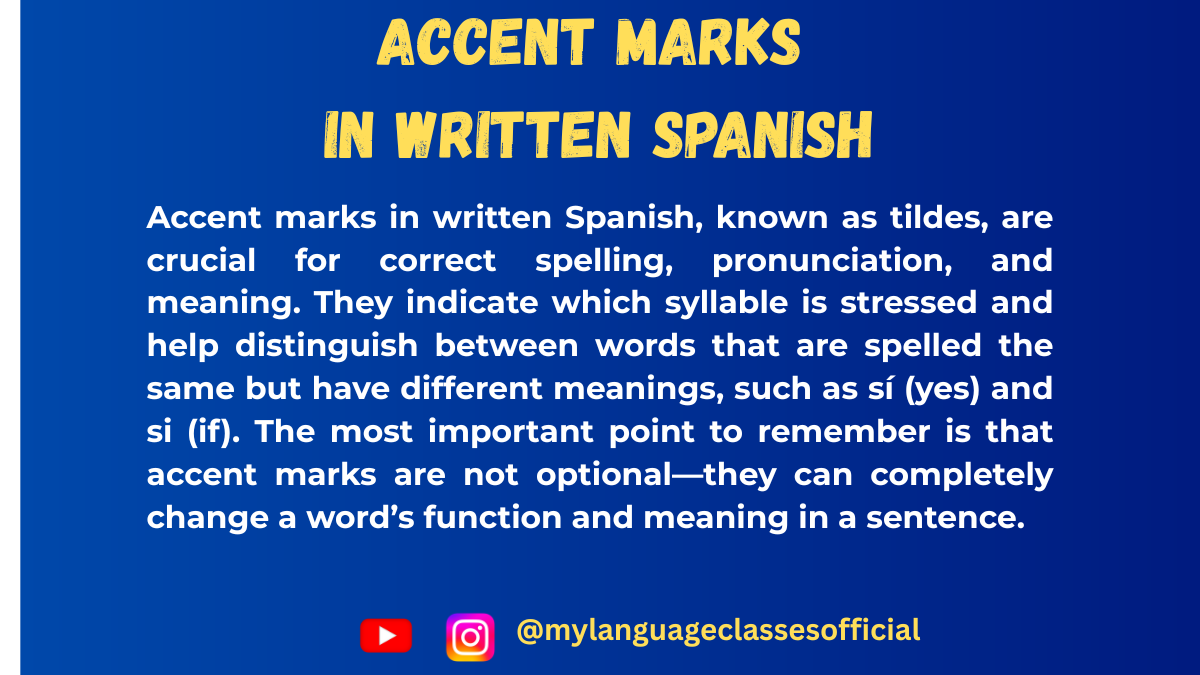
Correct Use of Accent Marks in Written Spanish
Spanish is a phonetic language, meaning words are pronounced as they are written. However, the correct use of accent marks (tildes) is crucial to ensuring clarity and avoiding misunderstandings. Accent marks in Spanish are not just decorative; they indicate stress and, in some cases, distinguish words that are otherwise spelled the same but have different meanings. Let’s explore how to use accent marks correctly and why they are so important.
The Importance of Accent Marks in Written Spanish
Accent marks can completely change the meaning of a word. For example:
- tú (you) vs. tu (your)
- Tú tienes un coche nuevo. (You have a new car.)
- Tu coche es nuevo. (Your car is new.)
- sí (yes) vs. si (if)
- Sí, quiero ir al cine. (Yes, I want to go to the movies.)
- Si quieres, podemos ir al cine. (If you want, we can go to the movies.)
- más (more) vs. mas (but)
- Quiero más azúcar en mi café. (I want more sugar in my coffee.)
- Quería ir, mas no pude. (I wanted to go, but I couldn’t.)
As you can see, missing an accent mark or placing one where it doesn’t belong can lead to confusion and change the meaning of a sentence entirely.
Rules for Using Accent Marks in Spanish
1. Words That Follow Natural Stress Rules (No Accent Mark Needed)
Spanish words naturally follow two stress rules:
- If a word ends in a vowel, ‘n’, or ‘s’, the stress falls on the second-to-last syllable.
- Example: casa (house), lápices (pencils), comen (they eat)
- If a word ends in any other consonant (except ‘n’ or ‘s’), the stress falls on the last syllable.
- Example: hotel (hotel), reloj (watch)
When words do not follow these natural stress rules, an accent mark is needed.
2. Words That Break the Natural Stress Rules (Require an Accent Mark)
- Example: canción (song), teléfono (telephone), inglés (English)
3. Differentiating Homonyms (Diacritical Marks)
Certain words have the same spelling but different meanings, distinguished by an accent mark:
- tú (you) vs. tu (your)
- sí (yes) vs. si (if)
- éste (this one) vs. este (this)
- qué (what) vs. que (that)
Example Sentences:
- ¿Qué quieres hacer? (What do you want to do?)
- Dijo que vendría. (He said that he would come.)
4. Interrogative and Exclamatory Words Need an Accent
Question words always have an accent mark:
- ¿Cómo te llamas? (What’s your name?)
- ¡Qué sorpresa! (What a surprise!)
5. Monosyllabic Words Usually Do Not Carry an Accent
Single-syllable words generally do not take an accent, except when distinguishing homonyms:
- tú (you) vs. tu (your)
- mí (me) vs. mi (my)
6. Accent Marks in Verb Forms
Verbs in the preterite and commands often require accents:
- está (he/she/it is) vs. esta (this)
- dé (give) vs. de (of, from)
Things to Keep in Mind
- Accent marks are essential and can change the meaning of a word completely.
- Follow natural stress rules and apply accents when needed.
- Learn and memorize common homonyms with accents.
- Question words always require an accent.
- Verb forms often require accents to maintain clarity.
Fill in the Blanks
- ___ (Tu/Tú) eres muy amable.
- No sé ___ (si/sí) puedo ir mañana.
- Me gusta este libro, pero prefiero ___ (aquel/aquél).
- No entiendo qué quiere decir ___ (mas/más).
- Voy a comprar ___ (mi/mí) coche nuevo.
- ¿___ (Que/Qué) hora es?
- Espero que Juan me ___ (dé/de) un consejo.
- No sé si ella está aquí ___ (aun/aún).
- ¿Te gusta el ___ (café/cafe)?
- Mi hermano siempre ___ (está/esta) ocupado.
Answers
- Tú eres muy amable.
- No sé si puedo ir mañana.
- Me gusta este libro, pero prefiero aquel.
- No entiendo qué quiere decir más.
- Voy a comprar mi coche nuevo.
- ¿Qué hora es?
- Espero que Juan me dé un consejo.
- No sé si ella está aquí aún.
- ¿Te gusta el café?
- Mi hermano siempre está ocupado.
Conclusion
Mastering accent marks in Spanish is essential for clear communication. A missing or misplaced accent can change the meaning of a word completely and lead to confusion. By understanding the rules and practicing regularly, you can improve your written Spanish and avoid common mistakes. Always double-check accent marks, especially in homonyms and verbs, to ensure your writing is accurate and professional. ¡Buena suerte!
If you enjoyed this lesson, be sure to check out more posts like this on my blog at My Language Classes. Don’t forget to subscribe my YouTube channel and follow me on Instagram for the latest language learning tips and lessons. Leave a comment below to share your thoughts, or ask any questions you have.
Happy learning! 😊
- tú (you) vs. tu (your)
-
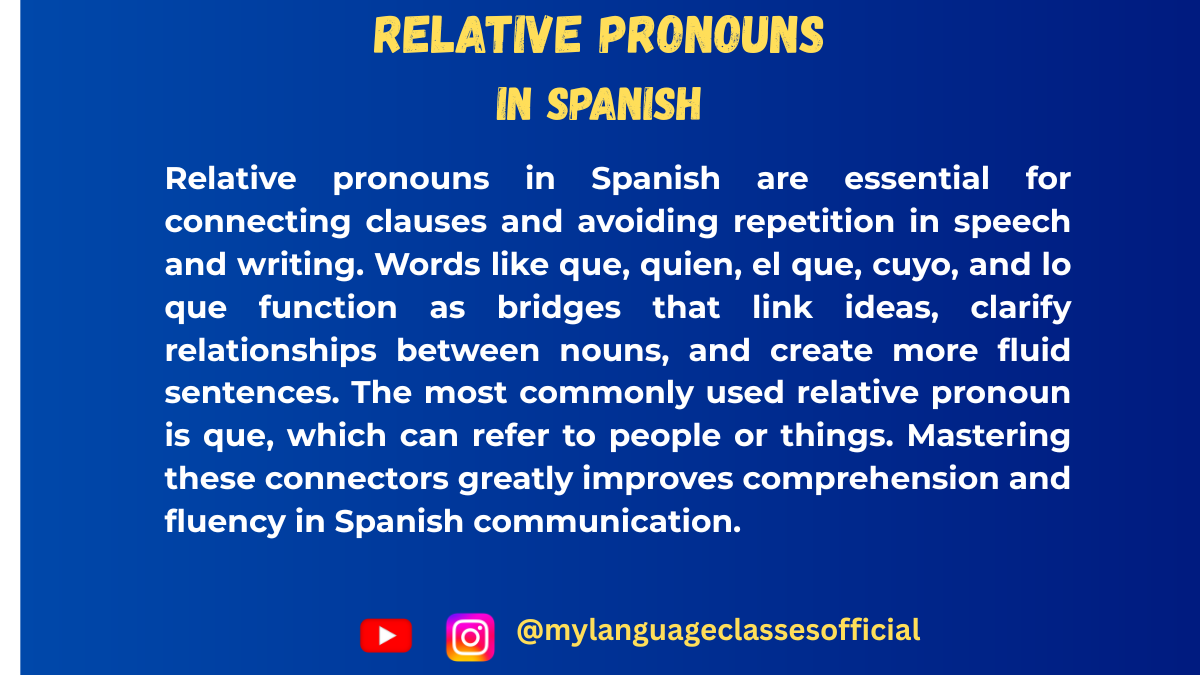
Relative Pronouns in Spanish: Que, Quien, Donde, and Others
When learning Spanish, relative pronouns are essential for connecting sentences smoothly and making speech more fluid. These pronouns allow us to refer to people, places, or things without unnecessary repetition. In this blog post, we will explore the different relative pronouns in Spanish, their meanings, and how to use them correctly.
List of Relative Pronouns in Spanish
Relative pronouns in Spanish are used to introduce subordinate clauses and refer to a previously mentioned noun (antecedent). Below is a list of the most common relative pronouns, their meanings, and example sentences:
Relative Pronoun Meaning Example Sentence 1 Example Sentence 2 Que That, which, who La casa que compré es muy grande. La película que vimos fue interesante. Quien / Quienes Who, whom Mi amiga, quien vive en Madrid, me visitó ayer. Los estudiantes, quienes aprobaron, celebraron. Cuyo / Cuya / Cuyos / Cuyas Whose El hombre cuyo coche es rojo está aquí. La chica cuya madre es doctora es mi amiga. Donde Where La ciudad donde nací es hermosa. Este es el restaurante donde cenamos anoche. El que / La que / Los que / Las que The one(s) who/that El libro, el que compraste, es interesante. Las chicas, las que llegaron tarde, son mis amigas. El cual / La cual / Los cuales / Las cuales The one(s) who/that (formal) La casa en la cual crecí está en ruinas. Los estudiantes, los cuales fueron premiados, estaban felices. Lo que What, which No entiendo lo que dijiste. Lo que más me gusta es viajar. Lo cual Which (referring to a whole idea) Perdimos el tren, lo cual fue un problema. Llegó tarde, lo cual nos molestó mucho. Cuanto / Cuanta / Cuantos / Cuantas As much/many as Toma cuanto quieras. Cuantas veces lo intentó, falló. More Example Sentences
- La mujer que trabaja en la tienda es muy amable.
- Mi amigo, quien es muy inteligente, siempre me ayuda.
- El perro cuyo dueño es mi vecino es muy juguetón.
- No entiendo lo que está pasando.
- El país donde nací es hermoso.
- Los estudiantes, los cuales estudian mucho, sacaron buenas notas.
- La casa en la que crecí tiene muchos recuerdos.
- No sé lo que quieres decir.
- Las flores que compraste son muy bonitas.
- La ciudad donde vivo tiene muchas atracciones turísticas.
Things to Keep in Mind
- Agreement in Gender and Number:
- “Cuyo” agrees in gender and number with the noun it modifies: El hombre cuyos hijos estudian aquí…
- “El que, la que, los que, las que” also change according to the noun they refer to.
- Use of Articles:
- “El cual, la cual, los cuales, las cuales” often appear with a preposition and are more formal.
- “Lo que” and “lo cual” refer to entire ideas or situations.
- Que vs. Quien:
- “Que” is used for both people and objects.
- “Quien” is used mainly for people and must match singular or plural (quien/quienes).
- Where to Use Relative Pronouns:
- “Donde” is for places.
- “Lo que” and “lo cual” refer to abstract concepts.
- “Cuyo” means “whose” and agrees with the possessed noun.
Fill in the Blanks
- La chica _______ vive al lado es muy simpática.
- El perro _______ dueño es mi vecino ladra mucho.
- No entiendo _______ dices.
- La ciudad _______ naciste es hermosa.
- Mi amigo, _______ es doctor, trabaja en el hospital.
- Las flores, _______ compraste ayer, están muy bonitas.
- Juan, _______ hermano es mi compañero, me ayudó con la tarea.
- La razón por _______ llegamos tarde fue el tráfico.
- No sabía _______ querías decir.
- El edificio _______ ventanas son grandes es nuevo.
Answers
- que
- cuyo
- lo que
- donde
- quien
- las que
- cuyo
- la cual
- lo que
- cuyas
Conclusion
Mastering relative pronouns in Spanish is essential for improving fluency and making speech more natural. Understanding the gender, number agreement, and context in which each pronoun is used will help you construct sentences more accurately. Keep practicing with different sentence structures, and soon, using these pronouns will become second nature.
If you enjoyed this lesson, be sure to check out more posts like this on my blog at My Language Classes. Don’t forget to subscribe my YouTube channel and follow me on Instagram for the latest language learning tips and lessons. Leave a comment below to share your thoughts, or ask any questions you have.
Happy learning! 😊
-

Use of Infinitive After Prepositions in Spanish
In Spanish, when a verb follows a preposition, it must always be in its infinitive form. Unlike English, where the gerund (-ing form) is often used after prepositions, Spanish strictly requires the infinitive. Understanding this grammatical rule is essential for forming correct sentences and sounding natural in Spanish.
This blog post will cover the different situations in which the infinitive is used after prepositions, common expressions with their meanings and examples, and essential points to keep in mind while using them.
Situations Where the Infinitive is Used After Prepositions
- Purpose or Goal (para + infinitive)
- Used to indicate the purpose or objective of an action.
- Example: Estudio para aprender. (I study to learn.)
- Means or Manner (con + infinitive)
- Expresses the way in which something is done.
- Example: Mejorarás con practicar. (You will improve by practicing.)
- Cause or Reason (por + infinitive)
- Indicates the reason for an action.
- Example: Me castigaron por llegar tarde. (They punished me for arriving late.)
- Condition (de + infinitive)
- Expresses conditions in certain phrases.
- Example: De saberlo, te lo habría dicho. (Had I known, I would have told you.)
- After Prepositions of Time (antes de/después de + infinitive)
- Used when referring to actions occurring before or after another action.
- Example: Voy a ducharme después de correr. (I am going to shower after running.)
- Prepositions Indicating a Point of Reference (sin, hasta, en, etc.)
- Used in fixed expressions and idiomatic phrases.
- Example: No puedes salir sin avisar. (You can’t leave without letting us know.)
Common Expressions with Infinitives After Prepositions
Expression Meaning Example 1 Example 2 Para estudiar To study Voy a la biblioteca para estudiar. Uso aplicaciones para estudiar español. Por llegar tarde For arriving late Me regañaron por llegar tarde. Perdí el tren por salir tarde. Con practicar By practicing Mejoras con practicar cada día. Con practicar, hablas mejor. Antes de dormir Before sleeping Leo antes de dormir. Me lavo la cara antes de dormir. Después de comer After eating Me cepillo los dientes después de comer. Llamó después de almorzar. Sin avisar Without warning No puedes irte sin avisar. Entró sin avisar. Hasta terminar Until finishing No salgo hasta terminar la tarea. No puedo descansar hasta terminar. De saberlo Had I known De saberlo, no lo habría hecho. De saberlo antes, te habría avisado. En aprender In learning Invierto tiempo en aprender español. Me esfuerzo en aprender bien. A pesar de fallar Despite failing Sigo intentándolo a pesar de fallar. Aprobó a pesar de fallar el primer intento.
More Example Sentences
- Fui al mercado para comprar frutas.
- No puedes entrar sin pagar la entrada.
- Me llamó después de haber terminado el trabajo.
- Logró su meta con dedicarse al estudio.
- Antes de salir, revisa tu mochila.
- Me fui temprano por evitar el tráfico.
- No puedes dormir sin apagar la luz.
- No podré jugar hasta mejorar mi salud.
- De haber sabido la verdad, habría reaccionado diferente.
- A pesar de tener miedo, enfrentó la situación.
Fill in the Blanks
- Voy al gimnasio ________ estar en forma. (para)
- Me castigaron ________ decir una mentira. (por)
- No puedes viajar ________ tu pasaporte. (sin)
- Voy a descansar ________ trabajar todo el día. (después de)
- No saldré ________ terminar el proyecto. (hasta)
- Aprendí español ________ estudiar mucho. (con)
- De ________ que vendrías, habría preparado algo especial. (saber)
- Siempre leo un libro ________ dormir. (antes de)
- Se esforzó mucho ________ ganar el premio. (para)
- Consiguió su objetivo ________ muchos intentos fallidos. (a pesar de)
Answers
- para
- por
- sin
- después de
- hasta
- con
- saber
- antes de
- para
- a pesar de
Things to Keep in Mind
- The verb after the preposition always remains in its infinitive form.
- Prepositions like para, por, sin, antes de, and después de commonly appear before infinitives.
- In cases where an article (el, la, los, las) is used, ensure agreement in gender and number.
- Some phrases change meaning slightly depending on the preposition used (e.g., por estudiar vs. para estudiar).
Conclusion
Using the infinitive after prepositions is a fundamental rule in Spanish. Unlike English, which often uses gerunds, Spanish requires the verb to stay in its base form. Mastering this concept will improve fluency and accuracy in constructing sentences. Practice with the expressions provided, and soon, this rule will become second nature in your Spanish conversations!
If you enjoyed this lesson, be sure to check out more posts like this on my blog at My Language Classes. Don’t forget to subscribe my YouTube channel and follow me on Instagram for the latest language learning tips and lessons. Leave a comment below to share your thoughts, or ask any questions you have.
Happy learning! 😊
- Purpose or Goal (para + infinitive)
-
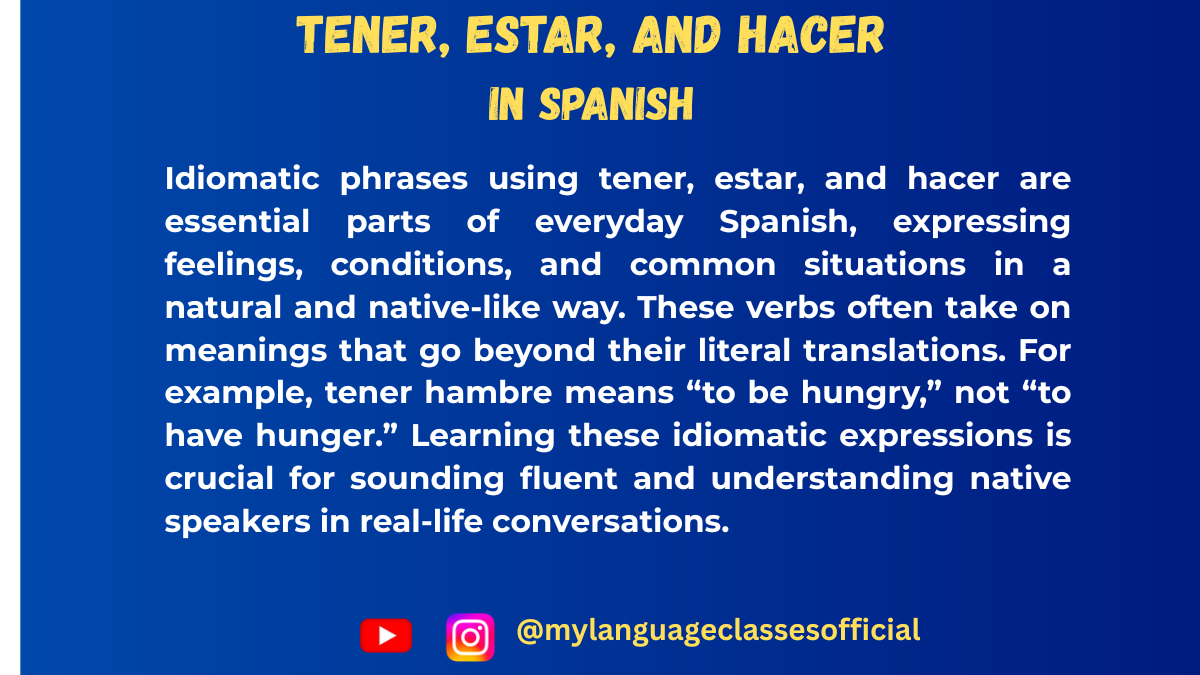
Idiomatic Phrases Using Tener, Estar, and Hacer in Spanish
Mastering idiomatic expressions is essential for achieving fluency in Spanish. Many common expressions in Spanish use the verbs tener (to have), estar (to be), and hacer (to do/make), which often don’t translate literally into English. In this blog, we will explore frequently used phrases such as tener razón, tener ganas de, estar de acuerdo, and many others, along with their meanings, uses, and examples.
Understanding Tener, Estar, and Hacer in Idiomatic Expressions
In Spanish, some expressions that involve states, desires, or idiomatic ideas use tener, estar, or hacer, instead of ser or other verbs we might expect in English.
- Tener is often used for conditions, feelings, or necessity.
- Estar is used for temporary states, emotions, and agreements.
- Hacer is commonly used for weather expressions and actions.
To form these idiomatic phrases, we follow these patterns:
✅ Tener + noun → (e.g., tener razón – “to be right”)
✅ Estar + prepositional phrase/adjective → (e.g., estar de acuerdo – “to agree”)
✅ Hacer + noun → (e.g., hacer frío – “to be cold (weather-wise)”)
Common Expressions Using Tener, Estar, and Hacer
Here is a list of beginner and intermediate-level expressions along with their meanings and example sentences.
Expression Meaning Example 1 Example 2 Tener hambre To be hungry Tengo hambre, ¿puedo comer algo? (I am hungry, can I eat something?) Los niños tienen hambre después de jugar. (The children are hungry after playing.) Tener sed To be thirsty Después de correr, siempre tengo mucha sed. (After running, I am always very thirsty.) ¿Tienes sed? Hay agua en la nevera. (Are you thirsty? There is water in the fridge.) Tener razón To be right Tienes razón, era una mala idea. (You are right, it was a bad idea.) El profesor tenía razón sobre la respuesta. (The teacher was right about the answer.) Tener ganas de + infinitive To feel like (doing something) Tengo ganas de viajar a España. (I feel like traveling to Spain.) No tengo ganas de salir hoy. (I don’t feel like going out today.) Tener cuidado To be careful ¡Ten cuidado con el perro! (Be careful with the dog!) Debes tener cuidado al cruzar la calle. (You must be careful when crossing the street.) Tener sueño To be sleepy Después de estudiar, tengo mucho sueño. (After studying, I am very sleepy.) Ella siempre tiene sueño por la mañana. (She is always sleepy in the morning.) Estar de acuerdo To agree Estoy de acuerdo contigo. (I agree with you.) Mis padres no están de acuerdo con mi decisión. (My parents do not agree with my decision.) Estar de buen/mal humor To be in a good/bad mood Hoy estoy de buen humor. (Today I am in a good mood.) Después del examen, estaba de mal humor. (After the exam, I was in a bad mood.) Hacer frío/calor To be cold/hot (weather) Hace mucho frío en invierno. (It is very cold in winter.) En la playa, hace calor. (At the beach, it is hot.) Hacer falta To be necessary/to need Hace falta estudiar para el examen. (It is necessary to study for the exam.) Nos hace falta más información. (We need more information.)
More Example Sentences
- Hace mucho viento hoy. (It is very windy today.)
- Tienes razón, esto no es fácil. (You are right, this is not easy.)
- No estoy de acuerdo con esa idea. (I do not agree with that idea.)
- Hace falta paciencia para aprender un idioma. (Patience is necessary to learn a language.)
- Ten cuidado, la carretera está resbaladiza. (Be careful, the road is slippery.)
- Siempre tengo ganas de comer pizza los viernes. (I always feel like eating pizza on Fridays.)
- Mi hermana tiene sueño porque estudió hasta tarde. (My sister is sleepy because she studied late.)
- En verano hace mucho calor en mi ciudad. (In summer, it is very hot in my city.)
- Después del trabajo, mi madre siempre está de buen humor. (After work, my mom is always in a good mood.)
- Los estudiantes no están de acuerdo con las nuevas reglas. (The students do not agree with the new rules.)
Fill in the Blanks
- ______ cuidado cuando cruzas la calle.
- Después de correr, ______ sed.
- ¿Tú ______ de acuerdo con esa decisión?
- Esta sopa está caliente, ______ falta más agua fría.
- En invierno ______ frío, así que uso un abrigo.
- Hoy no ______ ganas de salir.
- Mi hermana siempre ______ sueño por la mañana.
- Tú siempre ______ razón en las discusiones.
- Mis amigos y yo ______ de buen humor porque es viernes.
- ¡______ falta estudiar más para el examen!
Answers:
- Ten
- Tengo
- Estás
- Hace
- Hace
- Tengo
- Tiene
- Tienes
- Estamos
- Hace
Things to Keep in Mind
- Tener expressions use a noun, meaning they follow gender and number rules. Example: Tener hambre (hunger, feminine noun) vs. Tener ganas de (desires, plural noun).
- Estar expressions often use prepositional phrases such as de acuerdo or de buen humor.
- Hacer expressions are commonly used for weather, e.g., Hace frío instead of Es frío.
- Some phrases change based on the subject. Example: Tengo ganas de comer (I feel like eating) vs. Tenemos ganas de viajar (We feel like traveling).
Conclusion
Using idiomatic expressions with tener, estar, and hacer correctly will make your Spanish sound more natural and fluent. These phrases often don’t translate directly into English, so understanding their structure and use in different contexts is essential. Keep practicing these expressions in daily conversations to improve your fluency and confidence in Spanish!
If you enjoyed this lesson, be sure to check out more posts like this on my blog at My Language Classes. Don’t forget to subscribe my YouTube channel and follow me on Instagram for the latest language learning tips and lessons. Leave a comment below to share your thoughts, or ask any questions you have.
Happy learning! 😊
-

Time Expressions in Spanish: Hace + Time + Que, Desde, Desde Hace, and More
When learning Spanish, mastering time expressions is crucial for effective communication. Expressions like hace + time + que, desde, and desde hace help describe durations, points in time, and ongoing actions. In this blog post, we’ll explore these expressions in detail, provide examples, and offer practice exercises.
Common Spanish Time Expressions
Below is a list of commonly used time expressions in Spanish, their meanings, and example sentences:
Time Expression Meaning Example 1 Example 2 Hace + time + que “It has been (time) since…” Hace dos horas que estudio. (I have been studying for two hours.) Hace un mes que vivo en Madrid. (I have been living in Madrid for a month.) Desde “Since (a point in time)” Vivo en Madrid desde 2020. (I have lived in Madrid since 2020.) No como carne desde enero. (I haven’t eaten meat since January.) Desde hace “For (a duration of time)” Trabajo aquí desde hace cinco años. (I have been working here for five years.) No veo a Juan desde hace meses. (I haven’t seen Juan for months.) Hace + time “(Time) ago” Fui a España hace tres años. (I went to Spain three years ago.) Terminó la tarea hace una hora. (He finished the homework an hour ago.) Llevar + time + gerundio “To have been (doing something) for (time)” Llevo dos años aprendiendo español. (I have been learning Spanish for two years.) Lleva tres horas esperando. (He has been waiting for three hours.) Hace tiempo que “It’s been a long time since…” Hace tiempo que no te veo. (I haven’t seen you in a long time.) Hace tiempo que no viajo. (I haven’t traveled in a long time.) Desde que “Since (something happened)” Desde que me mudé, estoy feliz. (Since I moved, I am happy.) Desde que empezó el curso, estudio más. (Since the course started, I study more.) Al cabo de “After (time period)” Al cabo de dos años, me fui. (After two years, I left.) Al cabo de un mes, nos casamos. (After a month, we got married.) En cuanto “As soon as” En cuanto llegué, comimos. (As soon as I arrived, we ate.) En cuanto lo vi, supe la verdad. (As soon as I saw him, I knew the truth.) More Example Sentences
- Hace cinco minutos que llegué. (I arrived five minutes ago.)
- No veo a mi primo desde hace tres semanas. (I haven’t seen my cousin for three weeks.)
- Estudio español desde el año pasado. (I have been studying Spanish since last year.)
- Desde que cambié de trabajo, soy más feliz. (Since I changed jobs, I am happier.)
- Llevo un mes sin fumar. (I haven’t smoked for a month.)
- Hace dos años que conozco a Marta. (I have known Marta for two years.)
- Al cabo de unos meses, aprendí a nadar. (After a few months, I learned to swim.)
- En cuanto terminó la reunión, salimos. (As soon as the meeting ended, we left.)
- Hace tiempo que no voy al cine. (I haven’t been to the cinema in a long time.)
- Desde que empezó la pandemia, trabajo desde casa. (Since the pandemic started, I have been working from home.)
Fill in the Blanks
Fill in the blanks with the correct time expression.
- _______ dos horas que espero tu llamada.
- No veo a mi amigo _______ un año.
- Trabajo en esta empresa _______ hace cinco años.
- _______ empezó el curso, estudio mucho más.
- Mi hermano llegó _______ tres días.
- _______ un mes que no salimos a cenar.
- Llevo dos meses _______ practicar yoga.
- _______ compré este coche, no he tenido problemas mecánicos.
- _______ lo vi, me di cuenta de su felicidad.
- Al cabo _______ un año, decidimos mudarnos.
Answers
- Hace
- Desde hace
- Desde hace
- Desde que
- Hace
- Hace
- Sin
- Desde que
- En cuanto
- de
Things to Keep in Mind
- Gender and Number: Some time expressions require agreement in gender and number. For example, Hace un mes (one month) but Hace dos meses (two months).
- Articles: Desde hace is often followed by a duration (e.g., Desde hace tres años). However, desde alone is used with specific dates or points in time (e.g., Desde 2020).
- Different Uses: Hace + time is used for the past (e.g., Hace un año que fui a España), while Desde hace emphasizes duration.
- Llevar + gerund: This expression is similar to hace + que but emphasizes ongoing action (e.g., Llevo dos años estudiando español).
Conclusion
Time expressions in Spanish are essential for discussing events, durations, and actions. Understanding the differences between hace + time + que, desde, and desde hace will help you communicate fluently. Practice using these expressions in different contexts to improve your Spanish skills!
If you enjoyed this lesson, be sure to check out more posts like this on my blog at My Language Classes. Don’t forget to subscribe my YouTube channel and follow me on Instagram for the latest language learning tips and lessons. Leave a comment below to share your thoughts, or ask any questions you have.
Happy learning! 😊
-
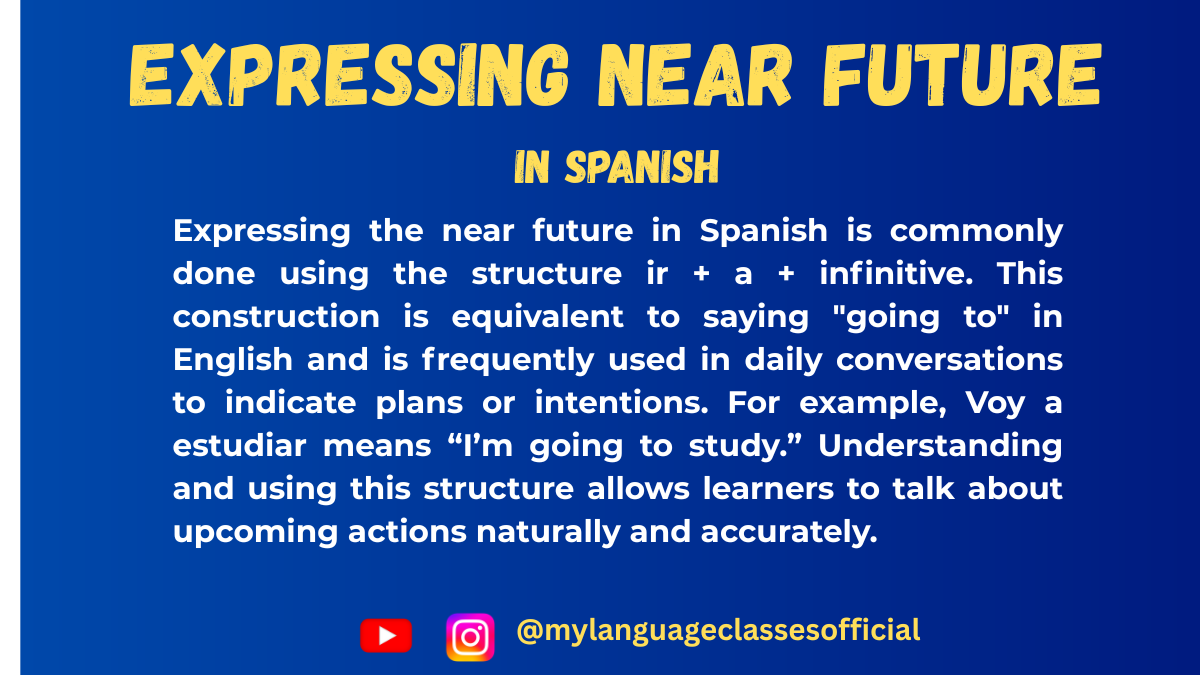
Ir a + Infinitive: Expressing Near Future in Spanish
In Spanish, the construction “Ir a + infinitive” is commonly used to express actions that will happen in the near future. This is equivalent to the English “going to + verb” structure. It is widely used in spoken and written Spanish and is easier to learn compared to the simple future tense.
Formation of “Ir a + Infinitive”
The structure consists of three elements:
- The verb “ir” (to go) conjugated in the present tense.
- The preposition “a” (to).
- An infinitive verb (unconjugated verb).
Conjugation of “Ir” in Present Tense:
Subject Pronoun Conjugation of “Ir” Yo voy Tú vas Él/Ella/Usted va Nosotros/as vamos Vosotros/as vais Ellos/Ellas/Ustedes van Sentence Structure:
Subject + Ir (conjugated) + a + Infinitive Verb
Example Sentences:
- Voy a estudiar. (I am going to study.)
- Vamos a viajar a México. (We are going to travel to Mexico.)
- Ellos van a comprar una casa. (They are going to buy a house.)
Usage of “Ir a + Infinitive”
1. Near Future Actions
Used to express something that is about to happen soon.
- Voy a llamar a mi madre. (I am going to call my mother.)
- Ella va a cocinar la cena. (She is going to cook dinner.)
2. Intentions or Plans
Used when someone has planned to do something.
- Vamos a ver una película esta noche. (We are going to watch a movie tonight.)
- Voy a aprender español este año. (I am going to learn Spanish this year.)
3. Predictions Based on Evidence
Used when there is evidence that something is about to happen.
- Va a llover. (It is going to rain.)
- El bebé va a llorar. (The baby is going to cry.)
4. Giving Commands or Warnings
Used to give warnings or strong suggestions.
- Vas a romper el vaso. (You are going to break the glass.)
- Van a llegar tarde si no se apuran. (You all are going to be late if you don’t hurry.)
Articles, Gender, and Plural Considerations
When using “Ir a + Infinitive,” remember:
- Definite Articles (el, la, los, las) and Indefinite Articles (un, una, unos, unas) should match the noun in gender and number.
- Example: Voy a comprar una bicicleta. (I am going to buy a bicycle.)
- Example: Vamos a visitar el museo. (We are going to visit the museum.)
- Verb agreement: The conjugation of “ir” changes based on the subject.
- The infinitive verb does not change regardless of the subject.
Common Verbs Used with “Ir a + Infinitive”
Here is a list of common verbs and their “Ir a + Infinitive” forms:
Infinitive Verb Meaning “Ir a + Infinitive” Example Comer To eat Voy a comer pizza. (I am going to eat pizza.) Beber To drink Vas a beber agua. (You are going to drink water.) Estudiar To study Ella va a estudiar matemáticas. (She is going to study mathematics.) Viajar To travel Vamos a viajar a España. (We are going to travel to Spain.) Comprar To buy Van a comprar un coche. (They are going to buy a car.) Hacer To do/make Voy a hacer mi tarea. (I am going to do my homework.) Tener To have Vas a tener una sorpresa. (You are going to have a surprise.) Llegar To arrive Ella va a llegar temprano. (She is going to arrive early.) Jugar To play Vamos a jugar fútbol. (We are going to play soccer.) Dormir To sleep Van a dormir temprano. (They are going to sleep early.) Regular and Irregular Verbs in “Ir a + Infinitive”
All verbs, whether regular or irregular, remain in the infinitive form after “a.”
Regular Verbs (AR, ER, IR Verbs)
- Hablar (to speak): Voy a hablar con mi amigo. (I am going to speak with my friend.)
- Comer (to eat): Vamos a comer paella. (We are going to eat paella.)
- Vivir (to live): Ellos van a vivir en Barcelona. (They are going to live in Barcelona.)
Irregular Verbs
- Hacer (to do/make): Voy a hacer la tarea. (I am going to do the homework.)
- Tener (to have): Ella va a tener una fiesta. (She is going to have a party.)
- Poder (to be able to): Van a poder salir temprano. (They are going to be able to leave early.)
Conclusion
The “Ir a + Infinitive” structure is one of the most practical and commonly used ways to express the near future in Spanish. It is simple to form and widely understood in all Spanish-speaking regions. By practicing this structure with different verbs, you can quickly improve your Spanish fluency and express future plans with confidence.
Now that you understand how to use “Ir a + Infinitive”, start practicing by forming your own sentences!
If you enjoyed this lesson, be sure to check out more posts like this on my blog at My Language Classes. Don’t forget to subscribe my YouTube channel and follow me on Instagram for the latest language learning tips and lessons. Leave a comment below to share your thoughts, or ask any questions you have.
Happy learning! 😊

